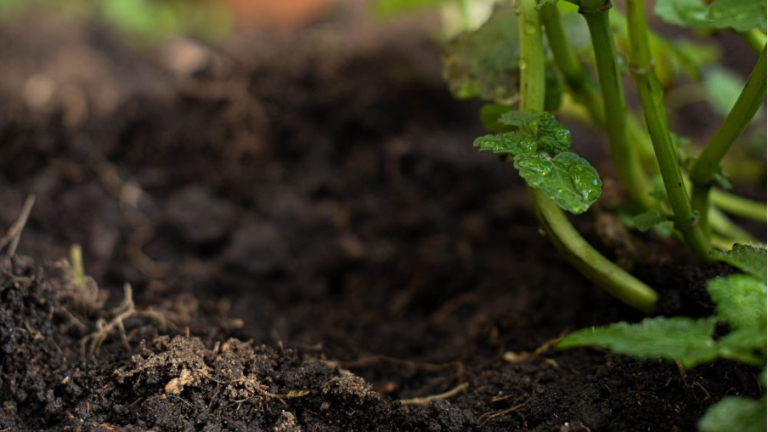The organisms that make up soil food webs are not evenly distributed throughout the soil. Each type or group of organisms lives in area with the right amount of food resources, space, nutrients and moisture. Soil organisms often cluster around plant roots, decaying animal and plant matter, on the surface of soil aggregates, and in the spaces between soil aggregates.
Soil biology
Healthy soil has a diverse and abundant population of microorganisms. One teaspoon of soil can contain about 1 billion microorganisms and 10,000 different species. However, dead or polluted soil may not have any microorganisms or the populations that are present may be harmful.
Creating a favorable environment for healthy soil microorganisms to live, in order to improve soil quality and plant health.
Plants and soil organisms communicate with one another in mutually beneficial symbiotic relationships in order to live and remain healthy. Plants provide the soil food web with food (the outputs of photosynthesis) and the soil food web provides the plants with nutrients and healthy soil conditions which in turn allow the plant to flourish.
In the process of fulfilling their metabolic functions, such as breaking down organic matter and cycling nutrients, the organisms of the soil food web produce critically important benefits for soil and plant health. Other crucial byproducts of the interactions and relationships between organisms in the soil food web, include increased nutrient availability to plants and optimal growing conditions in the soil through enhanced soil structure, increased water holding capacity and permeability, regulating pH and controlling pests and diseases.
Soil microorganisms absorb unutilised nutrients in the soil, preventing them from being leached. In this way, a healthy soil food web helps prevent nutrients entering and contaminating terrestrial water bodies and groundwater.
Nitrogen fixing bacteria have the capacity to ‘fix’ nitrogen from the atmosphere to provide for plants’ nitrogen needs and, where legume plants are the dominant vegetation type, the amount of nitrogen fixed by microorganisms is actually a large percentage of nitrogen in the soil.
Increase soil nutrient cyclling
Nutrient cycling is the name applied to the process whereby beneficial microorganisms use enzymes and other secretions to extract nutrients from parent rock materials and organic matter, and convert them into plant-available nutrients and humic substances.
At the molecular level, organic matter consists of structures that are not easily broken down. These structures contain complex carbon-based materials such as lignins and cellulose, and nutrients in forms that plants cannot take-up. For plants to be able to use the nutrients contained in these materials, they first need to be converted into plant-available forms (soluble inorganic mineral nutrients). The carbon-based materials need to be broken down (decomposed), and the nutrients need to be extracted from their exchange sites on both the organic matter and parent rock material.
Of the members of the soil food web, it is bacteria and fungi that produce enzymes capable of breaking down these structures, thereby releasing nutrients that they then absorb. These nutrients are then made available to plants in the root zone, when higher-order predators consume the bacteria and fungi and excrete the excess nutrients they gained from them. In natural systems untouched by modern fertilizers, it is these processes that have provided for the nutrition of all plants on earth for millions of years.
Controlling soil pH and preventing the growth of weeds.
When there is a healthy soil food web present, the plant can alter the constitution of the exudates it releases from its roots to attract and feed specific microorganisms. By releasing bacterial foods, bacteria are promoted and they produce alkaline substances to extract nutrients from their exchange sites which subsequently raise the pH. By releasing fungal foods, fungi are promoted, and they produce acidic substances to extract nutrients from their exchange sites which subsequently lower the pH. With perennial plants in place and a healthy soil food web, the pH can change every couple of micrometers along roots. Essentially, the plant is coordinating where and when it will alter the pH based on the nutrients it wants to be available. This multi-dimensional view of how pH, soil microorganisms, and plants interact demonstrates how natural systems balanced pH long before human disturbance. A balanced soil food web has a balanced fungal:bacterial ratio which creates a balanced pH overall because plants can uptake nutrients at all spectrums of pH availability simultaneously at all times.
The presence of beneficial fungi in the soil has been shown to significantly inhibit the growth of weeds. This is because beneficial fungi secrete acidic enzymes that inhibits the ability of nitrifying bacteria which converts ammonia to nitrate, a form of nitrogen that is very important for weed growth. In fact, using herbicides might creates better conditions for weeds to regrow.
The role of food webs in the decomposition of chemical and heavy metal residues in soil through the process of biological remediation.
The increasing use of different types of pesticides has helped to improve crop yields by reducingf crop losses due to pests and diseases. However, some pesticides persist in the environment due to their recalcitrant nature. Over time pesticides residues therefore accumulate in the environment to harmful levels that pose serious risks to human and environmental health.
What few people know is that some microorganisms in the food web under the soil break down the chemical bonds of the polluting active ingredients in pesticides and degrade them into simpler compounds that can easily be decomposed further by other microorganisms or processes. Heavy metals can also be biologically treated through the process of being assimilated or converted into organic matter and carbon in the soil. Win-win scenarios can be achieved by using biologically active extracts to control pests, and the biology contained in these can also go on to help to address the long-term problem of pesticide pollution in the soil, thereby reducing the use of pesticides, and bioremediating the pesticide contamination already present in the soil.
Management practices that harm the microbial life in the soil
Agricultural management practices have a strong impact on soil microbial health. Healthy microbial communities cannot be developed or sustained when the soil is dry or waterlogged for prolonged periods, is compacted, or lacking in organic matter. Maintaining constant ground cover with plants or trees is also essential because of the important relationships between plants and microorganisms and the function of ground cover in protecting soils from degrading forces of nature such as sun and rain. Improper tillage damages soil structure, disrupting the balance of microorganisms that live in it and physically crushing the larger members of the soil food web. As soon as the soil is disturbed, crucial elements of the soil food web begin to be removed. Once the bonds between the different elements of the soil food web are broken, soil functions will decline and degrading processes begin.
In addition, the use of chemicals such as fungicides, herbicides, and synthetic fertilizers will kill microorganisms such as fungi, nematodes, etc.
What other soil-related factors need to be considered to maintain good crop growth?
First, we need to identify the current condition of the cultivated soil by assessing key criteria that determine soil and plant health. These include moisture, pH, nutrient composition, water permeability, erosion, ground cover etc.These are assessed through various methods of soil testing. These will identify any issues that need to be addressed, and based on these, appropriate solutions can be developed that mitigate the issues highlighted in the soil tests. One of the most important strategies for ensuring soil health is to restore and maintain the soil food web as this has positive flow-on benefits for all other aspects of soil and plant health.
Steps to restore a healthy soil food web:
- Analyze soil samples under a microscope to identify the organisms present in the soil, their number, and their ratios;
- Use compost produced through aerobic decomposition or vermicompost to create beneficial microorganisms, organic matter, and add nutrients to the soil;
- Maintain aerobic conditions in the soil by promoting good soil structure and avoiding activities that may cause compaction or waterlogging;
- Be cautious of compost bought on the market, because if it is not produced properly, it may not have nutrients and contain anaerobic (pathogenic) organisms;
- Control erosion by planting suitable grasses depending on the slope;
- Create a plant cover that covers the soil to increase soil moisture and create a habitat (ecological niche) for soil organisms to develop;
- Avoid activities that disrupt the food web in the soil, such as excessive tillage.
(Article by an Australian soil microbiology expert Ehren Garner for CRED)








